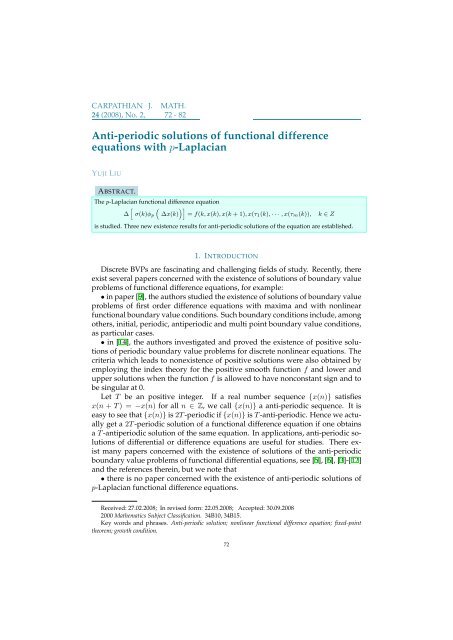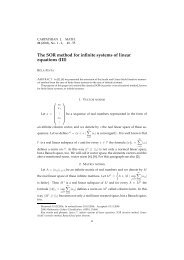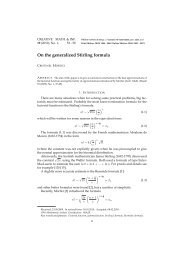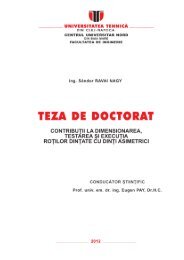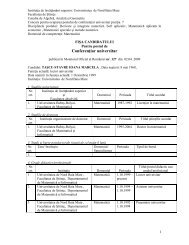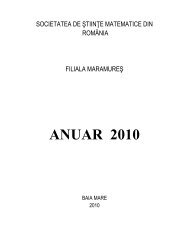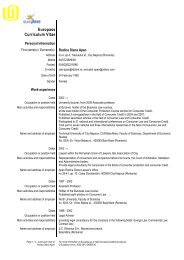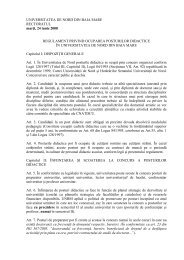Anti-periodic solutions of functional difference equations with p ...
Anti-periodic solutions of functional difference equations with p ...
Anti-periodic solutions of functional difference equations with p ...
Create successful ePaper yourself
Turn your PDF publications into a flip-book with our unique Google optimized e-Paper software.
<strong>Anti</strong>-<strong>periodic</strong> <strong>solutions</strong> <strong>of</strong> <strong>functional</strong> <strong>difference</strong> <strong>equations</strong> <strong>with</strong> p-Laplacian 77T∑−1T∑−1= ||q 0 || |x(u + 1)| θ+1 + ||p 0 || |x(n + 1)| θ+1u=0n=0( T −1) 1/(θ+1)∑+ ||r||T θ/(θ+1) |x(n + 1)| θ+1n=0⎛⎞θ/(θ+1)( m∑∑T −1) 1/(θ+1)+ ||p i || ⎝|x(u+1)| θ+1 ⎠|x(n+1)| θ+1i=1u∈{τ i(n)−1: n=0,...,T −1}T∑−1T∑−1≤ ||q 0 || |x(u + 1)| θ+1 + ||p 0 || |x(n + 1)| θ+1u=0n=0( T −1) 1/(θ+1)∑+ ‖r‖T θ/(θ+1) |x(n + 1)| θ+1 +T θ/(θ+1)n=0It follows that≤(β − ||q 0 || − ||p 0 || − T θθ+1||r||T θθ+1m∑||p i ||i=1( T∑ −1) −|x(n + 1)| θ+1n=0θθ+1∑n=0m ∑i=1) T∑ −1u=0.T∑−1‖p i ‖ |x(n+1)| θ+1 .n=0|x(u + 1)| θ+1∑It follows from (2.8) that β − ||q 0 || − ||p 0 || − T θθ+1 mi=1 ||p i|| > 0. Then there isM 1 > 0 such that ∑ T −1u=0 |x(u + 1)|θ+1 ≤ M 1 . So |x(n + 1)| ≤ M 1/(θ+1)1 for alln ∈ Z. We get ||x|| ≤ M 1/(θ+1)1 =: M.It follows from (2.9) that|∆y(n)| = |λf(n, x(n), x(n + 1), x(τ 1 (n)), . . . , x(τ m (n)))|≤maxn ∈ [0, T − 1]|x| ≤ M, |y| ≤ M|x i | ≤ M, i ∈ [1, m]∣ f(n, x, y, x 1 , . . . , x m ) ∣ =: M ′ .Since y(T ) = −y(0), we get that there exist 0 ≤ ξ ≤ T such thatThenHence0 − y(0)ξ − 0=y(T ) − y(0).T − 0∣ |y(0)| =ξ∣∣∣T∣T (y(T ) − y(0)) ∑−1≤ |∆y(k)| ≤ T M ′ .k=0n−1|y(n)| =∣ y(0) + ∑n−1∆y(k)∣ ≤ T M ∑′ + |∆y(k)| ≤ 2T M ′k=0for all n ∈ [0, T ]. It follows that‖y‖ ≤ 2T M ′ .k=0
<strong>Anti</strong>-<strong>periodic</strong> <strong>solutions</strong> <strong>of</strong> <strong>functional</strong> <strong>difference</strong> <strong>equations</strong> <strong>with</strong> p-Laplacian 81Pro<strong>of</strong>. Use Lemma 2.1, Lemma 2.2 and Lemma 2.5. The pro<strong>of</strong> is similar to that <strong>of</strong>Theorem L1 and is omitted.□3. TWO EXAMPLESIn this section, we present two examples to illustrate the main results insection 2.Example 3.1. Consider the following equation[(∆ 5 + sin nπ )(3.16)(∆x(n)) 3]Tm∑= β[x(n + 1)] 2k+1 + p i (n)[x(n − i)] 2k+1 + r(n), n ∈ Z,i=1where T ≥ 1, k ≥ 0 are integers, σ(n) = 5 + sin nπT , β > 0, p i(n), r(n) are T −anti<strong>periodic</strong>sequences.Corresponding to equation (1.1), we get φ p (x) = |x| 2 x, θ = 2k + 1 andσ(T ) = σ(0),g(n, x, y, x 1 , . . . , x m ) = βy 2k+1 +m∑i=1p i (n)x 2k+1ig(n, x, y, x 1 , . . . , x m ) = βy 2k+1 ,m∑h(n, x, y, x 1 , . . . , x m ) = p i (n)x 2k+1i + r(n).i=1+ r(n),It is easy to see that (H) holds. It follows from Theorem L1 that (3.16) has at leastone solution ifm∑||p i || < β.T 2k+12k+2Example 3.2. Consider the following equation[(∆ 5 − 10 sin nπ )(3.17)(∆x(n)) 3]22m∑= β[x(n + 1)] 2k + p i (n)[x(n − i)] 2k + r(n), n ∈ Z,i=1i=1where β ≠ 0, m > 1, k ≥ 1 are integers, p i (n), r(n) are 11-anti-<strong>periodic</strong> sequences.Corresponding to equation (1.1), we get φ p (x) = |x| 2 x, T = 11, σ(n) =5 − 10 sin nπ22, θ = 2k andσ(11) = −σ(0),m∑g(n, x, y, x 1 , · · · , x m ) = βy 2k + p i (n)x 2ki + r(n),i=1g(n, x, y, x 1 , · · · , x m ) = βy 2k ,m∑h(n, x, y, x 1 , · · · , x m ) = p i (n)x 2ki + r(n).i=1
82 Yuji LiuIt is easy to see that (K) holds if β > 0. It follows from Theorem L2 that (3.17) hasat least one solution ifm∑(3.18) 11 ||p i || < β.i=1It is easy to see that (L) holds if β < 0. It follows from Theorem L3 that (3.17) hasat least one solution ifm∑(3.19) 11 ||p i || < −β.i=1Acknowledgement. The author was supported by the Natural Science Foundation<strong>of</strong> Hunan Province (06JJ5008).REFERENCES[1] Aftabizadeh, A. R., Pavel, N. H. and Huang,Y. K., <strong>Anti</strong>-<strong>periodic</strong> oscillations <strong>of</strong> some second-orderdifferential <strong>equations</strong> and optimal control problems, J. Comput. Appl. Math. 52 (1994), 3-21[2] Aftabizadeh, A. R., Aizicovici, S. and Pavel, N. H., On a class <strong>of</strong> second-order anti-<strong>periodic</strong> boundaryvalue problems, J. Math. Anal. Appl. 171 (1992), 301-320[3] Aftabizadeh, A. R., Aizicovici, S. and Pavel, N. H., <strong>Anti</strong>-<strong>periodic</strong> boundary value problems for higherorder differential <strong>equations</strong> in Hilbert spaces, Nonl. Anal. 8 (1992), 253-267[4] Agarwal, R. P., Cabada, A., Otero-Espinar, V. and Dontha, S., Existence and uniqueness <strong>of</strong> <strong>solutions</strong>for anti-<strong>periodic</strong> <strong>difference</strong> <strong>equations</strong>, Arch. <strong>of</strong> Ineq. and Appl. 2 (2004), 397-412[5] Agarwal, R. P., Focal Boundary Value Problems for Differential and Difference Equations, Kluwer, Dordrecht,1998[6] Agarwal, R. P., O’Regan, D. and Wong, P. J. Y., Positive Solutions <strong>of</strong> Differential, Difference andIntegral Equations, Kluwer Academic Publishers, Dordrecht, 1999[7] Aizicovici, S. and Pavel, N. H., <strong>Anti</strong>-<strong>periodic</strong> <strong>solutions</strong> to a class <strong>of</strong> nonlinear differential <strong>equations</strong> inHilbert space, J. Func. Anal. 99 (1991), 387-408[8] Aizicovici, S., McKibben, M. and Reich, S., <strong>Anti</strong>-<strong>periodic</strong> <strong>solutions</strong> to nonmonotone evolution <strong>equations</strong><strong>with</strong> discontinuous nonlinearities, Nonl. Anal. 43 (2001), 233-251[9] Atici, F. M., Cabada, A. and Ferreiro, J., First order <strong>difference</strong> <strong>equations</strong> <strong>with</strong> maxima and nonlinear<strong>functional</strong> boundary value conditions, J. Diff. Equa. Appl. 12 (2006), 565-576[10] Chen, Y., <strong>Anti</strong>-<strong>periodic</strong> <strong>solutions</strong> for semilinear evolution <strong>equations</strong>, J. Math. Anal. Appl. 315 (2006),337-348[11] Chen, Y., Wang, X. and Xu, H., <strong>Anti</strong>-<strong>periodic</strong> <strong>solutions</strong> for semilinear evolution <strong>equations</strong>, J. Math.Anal. Appl. 273 (2002), 627-636[12] Chen, Y., Nieto, J. and O’Regan, D., <strong>Anti</strong>-<strong>periodic</strong> <strong>solutions</strong> for fully nonlinear first-order differential<strong>equations</strong>, Math. Comput. Modelling 46 (2007), 1183-1190[13] Gaines, R. E. and Mawhin, J. L., Coincidence Degree and Nonlinear Differential Equations, LectureNotes in Math. 568, Springer, Berlin, 1977[14] Merdivenci Atici, F., Cabada, A. and Otero-Espinar, V., Criteria for Existence and Nonexistence <strong>of</strong>Positive Solutions to a Discrete Periodic Boundary Value Problem, J. Diff. Equa. Appl. 9 (2003), 765-775DEPARTMENT OF MATHEMATICSGUANGDONG UNIVERSITY OF BUSINESS STUDIESGUANGZHOU 510320, CHINAE-mail address: liuyuji888@sohu.com


